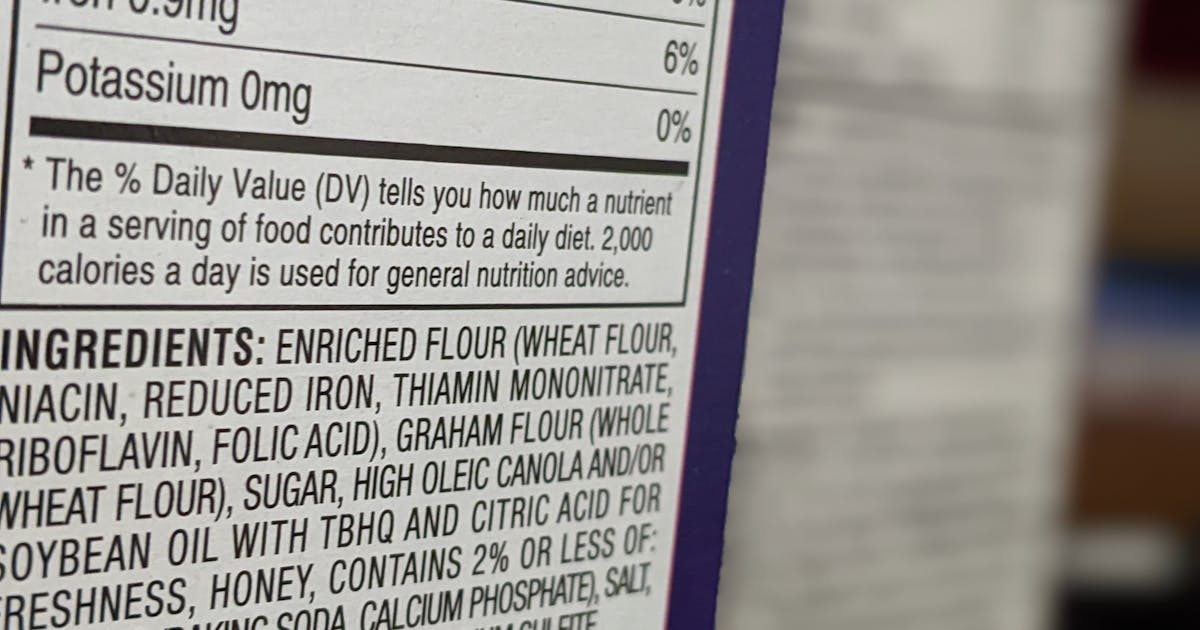Late last year the maker of Orville Redenbacher's popcorn was sued for putting mixed tocopherols in its "Naturals" line of microwave popcorn, which claims on the front of the package to have "Only Real Ingredients."
The preservatives, a form of vitamin E typically derived from vegetable oil, are used in a wide variety of food and cosmetic products and are allowed in foods that are certified organic. But a chemical process may be required to extract it. So is it natural?
No matter the outcome of the case, the convenience and affordability of many processed foods will continue to be powered by natural and artificial additives — something more people are trying to avoid even as many common ingredients remain poorly understood.
Nearly two-thirds of Americans say they seek foods made with "clean ingredients," according to a 2021 survey from the International Food Information Council (IFIC). Yet beyond fresh produce and other raw foods, that is open to broad interpretation as the U.S. Food and Drug Administration lacks a formal definition for the use of "natural" on food labels.
"Most people say they're paying more attention to ingredient lists, choosing clean ingredients and avoiding chemical-sounding ingredients," the food safety and nutrition nonprofit IFIC found in its survey. "When these respondents were asked how they define clean ingredients, 'not artificial or synthetic' was the top choice."
Dietitian Anna Rosales is asked about those ingredients all the time.
"My friends, family members and others come to me to share their ingredient woes and desire to have products with familiar ingredients in their pantries," said Rosales, senior director of government affairs and nutrition at the Institute of Food Technologists, a food science group.
"Understanding what's in food helps consumers select products they want and need," Rosales said. "This seemingly simple task can become confusing with scientific names used in ingredient labels as required by regulations."
Though any listed ingredient is FDA-approved or classified "generally regarded as safe," groups like the American Academy of Pediatrics have called into question the agency's approval processes and effects on children's health. Others take issue with the chemicals used in extracting food ingredients from natural sources.
More than 80% of Americans regularly have shelf-stable, canned or other packaged foods on hand in their pantries, according to another IFIC survey last year. Even for those adhering to clean-label diets, it's difficult to avoid all unfamiliar food additives.
Here are some of the ingredients Rosales is asked about most often, and a few others that often prompt Google searches of "Is it safe?" This is by no means an exhaustive list, as the FDA regulates thousands of chemicals the agency recognizes as safe for use in food in varying amounts.
Preservatives
To prevent the growth of mold, bacteria and other microorganisms, many processed foods turn to naturally sourced or synthetically produced preservatives. Some brands champion themselves as "preservative-free" or "nitrate-free" due to concerns that consuming too much of any of these can lead to negative health outcomes; other products may note the origin of their preservatives. Alternatives to preservatives include pasteurization, canning and freezing.
Potassium sorbate — One of the most common chemical preservatives, since it prevents spoilage without changing other qualities in food. It is metabolized into water and carbon dioxide and does not accumulate in the body; other than rare allergic reactions, research has not identified health hazards for humans when less than 25 milligrams per kilogram of body weight are consumed.
Potassium benzoate — Naturally occurring in cranberries and often added to sodas. When combined with ascorbic acid (vitamin C) and heat or light, the carcinogen benzene can be produced; otherwise the preservative does not carry proven health risks beyond possible allergic reactions when consumed sparingly.
Citric acid, sorbic acid, lactic acid, benzoic acid, propionic acid — These work to preserve food by making food and drink more acidic, and thus hostile for unwanted organisms. All can be sourced from either plants or human-made and are widely viewed as safe, though benzoic acid may cause allergic reactions in some.
Sodium or calcium propionate — Most commonly used to prevent mold in baked goods and long regarded as safe even at relatively high levels, though a recent Harvard study linked propionate to increased risk of obesity and diabetes. McDonald's removed propionate from its buns in 2018.
Sulfur dioxide — Commonly used in dried fruit to prevent discoloration or to prevent bacterial growth in wine. The use of sulfites, including sulfur dioxide, to preserve fresh fruits and vegetables has been banned by the FDA for over 35 years, and they cannot be used on foods that are sources of vitamin B1. Those with asthma or sulfite allergies should avoid it, but for others it is regarded as safe.
Nitrites/nitrates — Naturally occurring in the environment and in some foods and most often used to preserve meats and enhance their color. The National Cancer Institute says high intake of nitrites or nitrates can increase the risk of cancer; they can be found in high levels in drinking water in areas where nitrogen fertilizer is used.
BHT/BHA/TBHQ — Butylated hydroxytoluene, butylated hydroxyanisole and tert-butylhydroquinone are synthetic antioxidants used to prevent rancidity. The FDA regards these chemicals as safe in food in low doses; the Center for Science in the Public Interest gives an "avoid" rating to BHA and TBHQ and "caution" to BHT over cancer risks.
Fiber
Almost all Americans fail to regularly eat enough dietary fiber. Fiber is isolated from fruits, vegetables, grains and other plants, though some forms can be synthesized and added to food. Fibers also act to thicken, emulsify, gel or otherwise change the texture of food. The FDA has only recently recognized some types of fiber as sources of dietary fiber (all were already recognized as safe), which is why more "prebiotic" products containing inulin and other fibers have been hitting shelves. Some fibers may be more likely to cause gas and bloating than others, depending on the individual.
Common sources of fiber added to foods that are often derived from plants: Cellulose, guar gum, pectin, inulin, acacia (gum Arabic) and arabinoxylans.
Less common, often plant-sourced and still regarded as safe: Hydroxypropylmethylcellulose, high amylose starch and other "resistant starches," galactooligosaccharide, resistant maltodextrin, cross-linked phosphorylated RS4 and glucomannan.
For polydextrose, the Center for Science in the Public Interest advises consumers to "cut back," and the FDA requires a label over a potential laxative effect if more than 15 grams per serving are present.
Acidulants
Common acids used in food to enhance flavor and preserve flavors include citric acid, malic acid, acetic acid, phosphoric acid, ascorbic acid, lactic acid, sodium lactate and trisodium citrate. All are naturally occurring but typically are chemically synthesized for use in food.
Vitamins/Minerals
Breakfast cereal, fortified with a number of vitamins and minerals, helped make many of these nutrients household names.
Some vitamins that don't always get labeled with their corresponding letter are thiamin (B1) riboflavin (B2) niacin (B3) and folic acid (B9); the B vitamins, like others, are essential for normal body functions.
Miscellaneous
MSG - Monosodium glutamate is a flavor enhancer that occurs naturally in Parmesan cheese, tomatoes and other foods. Derived from starches or sugar, it is also used in a variety of packaged foods, like Doritos and Dot's pretzels. Despite self-reported complaints of reactions, research has not confirmed MSG is to blame.
Lecithin — Often labeled as soy lecithin to denote its source, lecithin is a group of chemicals used to emulsify food that occur naturally in eggs, soybeans, peanuts and elsewhere. It is a source of the essential nutrient choline. Research has not identified safety concerns for the use of lecithin as a food additive.
Propylene glycol - This type of alcohol has a range of uses, such as modifying flavors and textures, and retaining moisture. The FDA limits the amount that can be put in food as toxicity can occur at high levels, though when consumed in small amounts research has not found health effects for those who are not allergic to it.
Mono- and diglycerides — An emulsifier often found in bake mixes, margarine and a wide variety of other foods that the FDA and other organizations have not linked to negative health outcomes. However, they can contain trace amounts of trans fats, which have been shown to increase bad cholesterol and reduce good cholesterol.
Adblock test (Why?)
What the heck is potassium sorbate? Demystifying common 'chemical sounding' food ingredients - Star Tribune
Read More

/cloudfront-us-east-2.images.arcpublishing.com/reuters/GCT5PKTBXNLXHJSIZIGFSYYSDU.jpg)

















